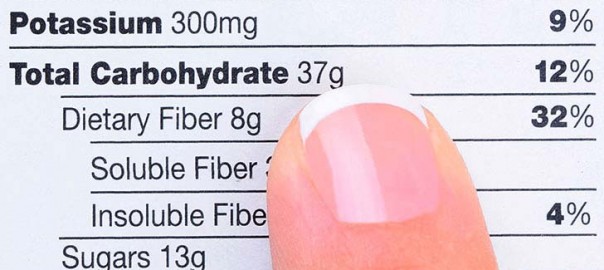
The Easy Guide to Counting Carbs
Success on a low carb diet takes dedication, and a solid understanding of how low carb diets actually works to help you lose weight and stay healthy. One of the most critical parts of adapting to the low carb lifestyle is learning the proper way to count the carbs of the foods you eat. There are a few tricks to learn when starting to count your carbs, but with a little advice and some tips, it’s very easy to learn the proper carb counting methods.
This handy reference guide to carb counting includes a handful of tips that you’ll find helpful, some explanations of some terminology you’ll need to know, and a breakdown of the differences between the main types of carbs you’ll be counting. So, if you’re ready, let’s get started!
Why is Counting Carbs Important?
If you’ve ever heard the old saying ‘calories in, calories out’, then you already know the basic premise behind why the low carb diet works. However, there’s a bit more to it than that. Everyone’s body processes certain foods a little differently than others, and because of this, some people benefit more from certain types of foods than others. This is where the low carb diet makes such a difference. One of the most common causes of weight gain is an excess of carbohydrates in our diets. Some people are affected more than others, but we can all benefit from paying attention to the amount of carbs we take in.
By choosing to go low carb, it’s very important to know how many carbs are in the foods we eat so that when we start to make changes to our diets, we understand how each food choice adds up to impact our total intake of carbs. In addition, counting carbs gives a measurement you can use to understand how much a particular food item will impact your blood glucose level, which is critical information for anyone who is diabetic.
What Kinds of Carbs do we Count?
Carbs come in the form of simple sugars and starches. Sugars have names like sucrose (ex: table sugar), fructose (ex: fruit sugars) and lactose (milk sugars). Starches are the carbs found in foods like bread, rice, and vegetables like potatoes. Starches are broken down in to simple sugars as part of your digestion before they enter the bloodstream.
We also need to count what are known as sugar alcohols. These are commonly found in low-calorie or reduced-calorie foods and act as alternative sweeteners. You probably know them by their common names such as sorbitol, malitol, and several other ingredients that end in –ol.
Read: What Are Good Carbs? – Atkins.ca
How to Count Carbs
While there are some differing opinions on how to precisely define what is a carb and what isn’t, there is general consensus on the fact that not all carbs affect the body in the same way. Simple sugars and refined starches are absorbed in the body more rapidly, whereas other types of carbohydrates such as certain types of fiber are absorbed more slowly, and some isn’t even digested at all. This is where we start to get in to the difference between ‘total carbs’ and ‘net carbs’. Let’s define these terms:
Total Carbs – This is the total amount of carbohydrates in the portion of food that you are eating. This includes all types of carbs, regardless of whether they are digestible or not.
Net Carbs – This is the amount of carbs that will be digested or absorbed by your body, typically defined as Total Carbs minus Indigestible Carbs, generally shown as fiber grams, and the amount of Sugar Alcohols.
So the formula works out like this:
- Total Carbs – Indigestible Carbs – Sugar Alcohols = Net Carbs
Here’s an example:
- 15g Total Carbs – 7g fiber – 2g sorbitol = 5g Net Carbs
Now that you know what the difference is between Total Carbs and Net Carbs, you can start putting this information in to practice. To do this, you really need to start paying attention nutrition labels and serving sizes.
Nutrition Labels
All nutrition labels in Canada are required to specify the serving size they use to calculate their nutritional content, including the amount of carbs, sugars, and fiber.
Read: Government of Canada – Nutrition Labelling
Be wary of labels that contain terms such as ‘impact carbohydrates’, as these can be deceptive. Not all manufacturers agree on what ‘impact carbohydrates’ are, but they are intended to convey what the manufacturer believes is the amount of carbs expected to impact a normal diet. This is why impact carbs should not be relied on as a definitive measure. Since every body and every diet will be a little different, 10 grams of impact carbohydrates for one person may have the same affect as 20 grams for another person. In these cases, it’s best to do the math yourself and be sure.
By understanding how many carbs are in the portion sizes you are eating, you can quickly learn just how many carbs you are taking in at each meal. This is crucial information you will need to track your carb intake and make sure that you’re sticking to your low carb diet plan.
Carb Counting Summary
Counting carbohydrates is something that all low carb dieters should take seriously, as it’s the only real way to understand how your diet is progressing and what changes you may need to make along the way.
In addition, counting carbs is one of those things that gets easier with practice, so the more you do it the better you’ll get at it. Especially when you start to learn how to estimate serving sizes at a glance. You’ll be surprised how it eventually becomes second nature, and it won’t seem so daunting after you learn the ropes.
We’re here to help if you have any questions about how to count carbs, so feel free to pop in to any of our store locations, or contact us online and we’d be happy to get back to you. We hope you found this guide helpful, and we wish you good luck with your carb counting!






